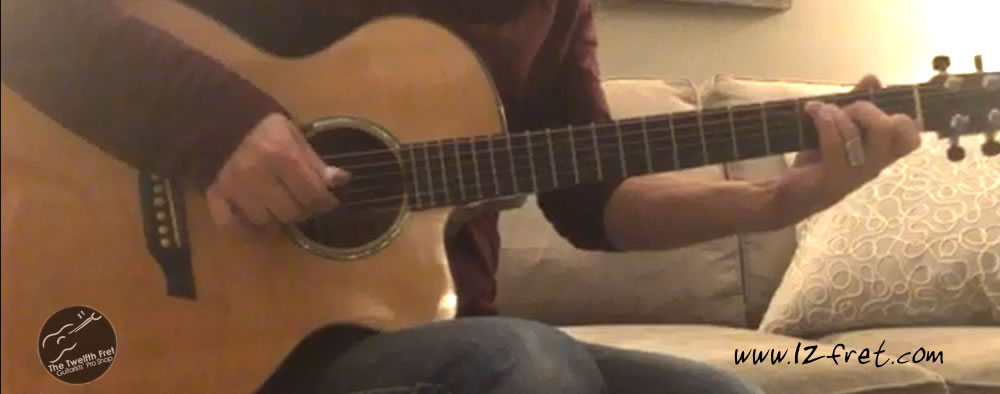
How To Spice Up Your Travis Picking by Using The Up Beats
Travis picking is a great tool that every fingerpicker should have in their bag. It’s the backbone to many popular songs both past and present and offers the player almost endless variations. This article will just begin to scratch the surface of how to take simple alternating thumb patterns and turn them into more interesting ideas.
Here is what I would consider to be about the most basic Travis style pattern. We will be using a first position C major chord for this example but of course this applies in one way or another to any chord on the guitar. Let’s start by fretting our chord and then applying the right hand picking. To start we will simply play thumb (5th string) index finger (3rd string) thumb (4th string) middle finger (2nd string) that gets us half way through a bar of 4/4 time. To finish the bar we are going to simply do it again. This pattern I would consider to be one of the most basic Travis style patterns, so let’s begin here. First off, here is what that sounds like.
VIDEO 1
I’m a big fan of the Travis style so I like it already, but there is a lot that can be done with this to make it less repetitive and less predictable. Let’s begin by taking the last note of the 4 beat pattern above (the up beat after 4) and change it to the open first string. I’m always amazed at how just a little thing like this can really change the overall feel of the pattern. This new variation sounds like this.
VIDEO 2
Here is a third variation by simply alternating the first 4 beat pattern in video 1 with its variant pattern in VIDEO 2
VIDEO 3
Now let’s go a bit further and begin by changing both the up beat following beat 2 and beat 4. I’m going to play a little descending pattern starting on the note G on the first string on the up beat of 2 followed by the note F on the same string on the up beat of 4 followed by the open E string on the up beat of 2 followed by the note D on the up beat of 4 and then back into the very first basic pattern. That sounds like this. Notice how it really comes alive when you speed it up a bit too.
VIDEO 4
The pattern is now really starting to sound like two separate parts and of course that’s what we’re after. A few tips before going a bit further. Each chord is going to present its own unique set of challenges to the left hand as you add notes to the chords you are playing. In the above example it’s important to be able to move the index finger cleanly between just fretting the note C on the 2nd string (allowing the open E string to ring clearly) and barring both the 1st and 2nd string (allowing the note F on the first fret of the 1st string to ring clearly). It’s really important that the added melody notes don’t sound clunky and that they float above the chord as though someone else is playing them so you might want to spend some time making sure that transition is smooth. I like to tell students you never want to sound like what you are playing is tying your fingers in knots, even if it actually is. Using the up beats here also really adds to the sense that the melody is floating above the chords below as the Travis pattern is dictating that the chord tones are being played on the down beats.
Let’s go on a little bit more and add that melody to another chord, in this case let’s do G. So what I’m doing here is the exact same melody but I’m Travis picking a G chord now for the variation but still returning to the same basic C major pattern we started with.
VIDEO 5
There are a few things to notice here and as we get more complicated there will be more and more things to point out with both hands, but let’s just isolate a few. First off, I played the G chord a little differently so I could smoothly return to the C chord at the end. I also changed the G chord to the C chord but left the melody note D ringing over that change to keep things smooth. In other words, I’m still thinking about the melody above and chords below as two different things and not necessarily changing them all at the same time. It’s important to realize every little sequence can require its own little unique tweak in order to sound its best.
Phrasing is also important as well. I’m really trying to emphasize the moving notes while keeping the other parts solid and even when I play this kind of thing, and again each little moment will probably require its own tweak and two different players may handle the problem in different ways as well.
Here is the same little melody on a few different open chords in the same key as our original G and C chords.
VIDEO 6
Notice how even the same simple little melodic passage can sound even more interesting when played on the up beats of some different chords. By making a few more simple changes we can add even more interest by doing things like playing the little melody forward and then backward or by changing the intervals slightly so feel free to experiment with different variations to add even more interest to the basic chords.
This technique can also be used very effectively to add the vocal melody of a favorite song to the finger picked chords creating a nice solo guitar arrangement of some things you may already know.
The sky’s the limit here so feel free to experiment and explore!
David Martin – The Twelfth Fret Music School
